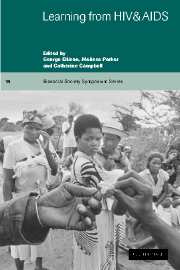Book contents
- Frontmatter
- Contents
- List of contributors
- Foreword by D. Clarke-Patel
- 1 Introduction. Learning from HIV and AIDS: from multidisciplinary to interdisciplinarity
- 2 HIV and the evolution of infectious diseases
- 3 The epidemiology of HIV/AIDS: contributions to infectious disease epidemiology
- 4 The influence of HIV/AIDS on demography and demographic research
- 5 What have clinicians learnt from working with HIV/AIDS? A medical perspective from London
- 6 How has the HIV/AIDS pandemic contributed to our understanding of behaviour change and health promotion?
- 7 Anthropological reflections on HIV prevention strategies: the case for targeting London's backrooms
- 8 An absence of anthropology: critical reflections on anthropology and AIDS policy and practice in Africa
- 9 A disaster with no name: the HIV/AIDS pandemic and the limits of governance
- 10 Postscript: reflections on HIV/AIDS and history
- Country index
- Subject index
- References
3 - The epidemiology of HIV/AIDS: contributions to infectious disease epidemiology
Published online by Cambridge University Press: 14 January 2010
- Frontmatter
- Contents
- List of contributors
- Foreword by D. Clarke-Patel
- 1 Introduction. Learning from HIV and AIDS: from multidisciplinary to interdisciplinarity
- 2 HIV and the evolution of infectious diseases
- 3 The epidemiology of HIV/AIDS: contributions to infectious disease epidemiology
- 4 The influence of HIV/AIDS on demography and demographic research
- 5 What have clinicians learnt from working with HIV/AIDS? A medical perspective from London
- 6 How has the HIV/AIDS pandemic contributed to our understanding of behaviour change and health promotion?
- 7 Anthropological reflections on HIV prevention strategies: the case for targeting London's backrooms
- 8 An absence of anthropology: critical reflections on anthropology and AIDS policy and practice in Africa
- 9 A disaster with no name: the HIV/AIDS pandemic and the limits of governance
- 10 Postscript: reflections on HIV/AIDS and history
- Country index
- Subject index
- References
Summary
Introduction
The emergence of HIV/AIDS in the mid-1980s challenged the theoretical basis of epidemiology. From the beginning of the epidemic, HIV/AIDS imposed its rules by successfully attacking and eluding host defence mechanisms, by infecting all strata of different populations and continents in successive epidemic waves of variable amplitude, and by interacting with many other diseases. The propensity of the infection to spread and be maintained in the population, and the difficulty in altering its course with prevention efforts, has forced scientists to develop innovative methodological and preventive approaches to help understand and control the spread of HIV/AIDS.
In this chapter we illustrate from an epidemiological perspective how progress has been made in understanding and controlling the transmission of HIV/AIDS. The primary aim of epidemiology can be split into four areas: to characterise patterns of disease spread (descriptive epidemiology); to understand the factors underlying its spread (theoretical epidemiology); to predict its future course in the absence of intervention; and to evaluate the best options for treatment and control. A great deal has already been written on the first of these areas characterising the spread of this new disease throughout the world. Our focus in this chapter is therefore on the latter three aspects. Throughout the chapter, our emphasis is on the use of theoretical models of HIV/AIDS transmission, which have been instrumental in improving our understanding of the factors allowing the disease to persist and spread, in understanding the course of the disease, and in evaluating the effectiveness of various control strategies.
- Type
- Chapter
- Information
- Learning from HIV and AIDS , pp. 59 - 87Publisher: Cambridge University PressPrint publication year: 2003
References
- 1
- Cited by

